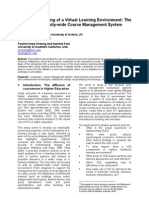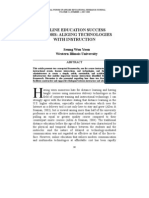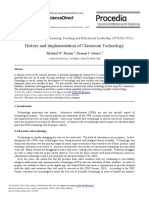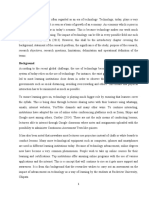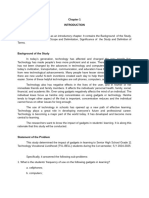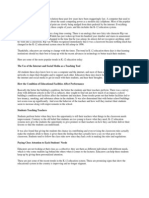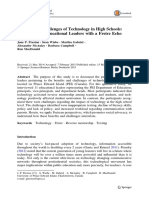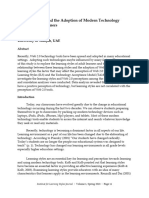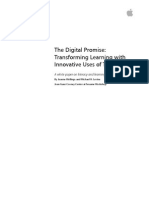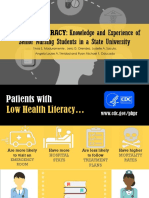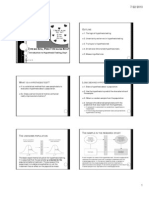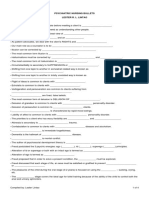Technological Changes in Student Affairs Administration: Chapter Twelve
Technological Changes in Student Affairs Administration: Chapter Twelve
Uploaded by
Ryan Michael OducadoCopyright:
Available Formats
Technological Changes in Student Affairs Administration: Chapter Twelve
Technological Changes in Student Affairs Administration: Chapter Twelve
Uploaded by
Ryan Michael OducadoOriginal Title
Copyright
Available Formats
Share this document
Did you find this document useful?
Is this content inappropriate?
Copyright:
Available Formats
Technological Changes in Student Affairs Administration: Chapter Twelve
Technological Changes in Student Affairs Administration: Chapter Twelve
Uploaded by
Ryan Michael OducadoCopyright:
Available Formats
CHAPTER TWELVE
TECHNOLOGICAL CHANGES IN STUDENT
AFFAIRS ADMINISTRATION
M. Lee Uperaft and Harold Goldsmith
echnological innovations and applications are rapidly transforming our society. This transformation has touched almost every aspect of our lives and
its impact seems to be accelerating. Bill Gates has said technology is the revolution about which we have no choice (Gates, 1995). Higher education has lagged
behind many other sectors of society in the adoption of technology as an administrative, learning, and communication tool. This, however, is changing as external forces and internal adaptations are compelling the adoption of new
technological tools to compete successfully with both other higher education institutions and the corporate sector, as well as meet the challenges of an increasingly computer literate student body. There are many examples of these trends:
At California State University's newest campus at Monterey Bay, one building
is conspicuously absent from their blueprints: the library. The campus will
instead rely on technology for information retrieval.
The Western Governors' University, with its cyberspace campus and virtual
classrooms, has taken steps toward full accreditation. Many other campuses,
states, and regions are developing "virtual" campuses and enrolling students
worldwide.
At a leading research university, it is now possible to inquire about and apply
for admission, get admitted, accept admission, receive advising, and enroll for
216
Technological Changes in Student Affairs Administration
217
courses entirely through technological means without ever talking to another
human being, either face to face or by telephone.
All of these trends, of course, directly and indirectly impact student affairs.
The nature of our work, our investment in face-to-face relationships, and our
reliance on students being physically present on our campuses has made our adoption of technological innovations somewhat cautious. As with most technological changes, early adopters have shown the way and advocated for its use. Student
affairs administrators, however, have many questions. "Is the technological revolution a journey to higher levels of human experience or a gigantic leap into the
abyss of total mechanization of the human race? Or will it be neither?" (Upcraft and Terenzini, 1999, p. 1) It is clear that student affairs professionals will need
to become more knowledgeable about the uses and limitations of technology as
well as the influence it will have on students and their learning and development
if we are to fulfill our obligations to future student generations.
In this chapter, we will discuss the larger context of the technological revolution and the impact of technology on student learning and the delivery of student services and programs. The "downsides" of technology will also be discussed.
Finally, the implications for student affairs policy and practice will be reviewed.
Technology, Society, and Higher Education
We are now in a time of unprecedented change. Naisbitt and Aburdene (1990) assert that "new technologies have changed the importance of scale and location
and extended the power of individuals" (p. 301). They describe how technology
empowers individuals by connecting them with the world electronically. Naisbitt
and Aburdene also assert that the truly global cities of the 21st century will be the
smartest and not the largest. These themes of individual empowerment and global
networks are echoed by Louis Perleman (1992) who describes the technological
transformation of the late 20th century and ends with the optimistic idea that "the
same technology that is transforming work offers the new learning systems to solve
the problems it creates" (p. 50).
The relationship between learning, technology, and work is the central theme
of the work of Davis and Botkin (1994). Their thesis is that since learning is now
the work of most businesses, learning is too important to be left to traditional
higher education organizations. Business and industry should take over much of
what is called traditional higher education in order for American business and industry to remain or get competitive in the global economy. Dollence and Norris
218
The Handbook of Student Affairs Administration
(1995) assert that the need for learning in the knowledge society is so great that
not enough traditional institutions could be built to accommodate the need, but
see a great opportunity for higher education to meet this need through the adoption of technology.
The debate outside and inside higher education has been intense. Few would
argue that, on the whole, American higher education has been a success by most
measures. That it is still one of America's most popular exports attests to its value.
The question is the ability of higher education to respond to the opportunities and
challenges presented by technology. Western Governor's University is one such
response. Thirteen western states decided not to build additional campuses in the
face of double-digit enrollment growth projections for the next ten years, but rather
to create and offer entire degree programs to all students on-line. Daniel (1996)
argues that this need for access to higher education is a worldwide problem and
the only way to provide it is through alternative instructional models, including
technology.
That this transformation of society and higher education will influence student affairs should be evident from the context provided. As the delivery systems
and missions of higher education are influenced by technology, the profession and
practice of student affairs will be greatly affected in many ways.
Comparing Traditional and Emerging Learning Models
In the traditional higher education and student affairs model, learning and campus are synonymous. The campus is essential because it is a place where the physical facilitieslaboratories, libraries, classrooms, residencesare located; where
faculty, students, and administrators reside. The dominant mode of delivery of
educationthe classroom and the labrequires that groups of students and a
faculty member be in the same place at the same time on a regularly scheduled
basis over some period of time, usually a semester. In the new learning models (see
Figure 12.1), the learner will have many more choices about the way in which
learning occurs. The traditional classroom is now in competition with compressed
video, the Internet, videotape, computer self-guided learning and simulations, interactive learning, and other technology-based learning environments. Because
technology can mediate so many kinds of instruction, competency rather than inclass time is the measure of learning, the traditional academic calendar is obsolete, learning may be pursued on an individual basis, and the pace of learning is
modified to meet learner needs.
Given these changes, the out-of-classroom environment also undergoes a radical transformation. The physical presence of groups of students in one place is
no longer required and those students who do assemble on a campus will have
Technological Changes in Student Affairs Administration
219
FIGURE 12.1 THE IMPACT OF TRADITIONAL AND EMERGING
TECHNOLOGY ON STUDENT AFFAIRS (GOLDSMITH, 1992)
Feature
Traditional
Emerging
Campus
Teaching
Programs
Phsycial Place
Face to Face
Campus Based
Face to Face
Small Groups
18-21 Age Focus
Creation of:
Environments
Experiences
Interactions
Campus Focused
Information Node
Multiple Options
Student Based
Audio/Video
Computer Assisted
Resources
Creation of:
Interventions
Resources
Options
Student Focused
Student Development
Student Services
their lives outside the classroom greatly influenced by technology. The practice of
student affairs, therefore, must shift from a campus-based model to a learner-based
model, wherever that learner is. The implications for the delivery of student services and programs are enormous. The emphasis will shift from providing resources in a campus environment to linking the learner with those resources
wherever the learner is located and whenever those resources are needed.
The Impact of Technology on Student Learning
Uperaft and Terenzini (1999) posit the increased reliance on technology in the
classroom as one of the emerging trends. Even conventional courses are being impacted by available technology. Students are often required to search the Web in
order to write papers or do class projects. Faculty members' expectations about
the use of the most recent information are heightened by the availability of the
Internet. In some cases, video conferencing is used to bring experts into class or
to have discussions with students from other parts of the world. In some laboratory classes, advanced simulations are used to conduct chemical experiments, study
anatomy, or practice world politics.
E-mail is used for students to communicate with instructors or with other classmates. Some faculty members are now establishing class "chat rooms" and class
listservs that allow students to link to one another. Some faculty members are requiring students to use e-mail to submit papers and class assignments and giving
students feedback in the same way.
Students are also taking courses by compressed video or satellite feeds. A faculty member may not even be in the same location as the students, but can see
220
The Handbook of Student Affairs Administration
and hear students in remote locations. E-mail connections, the telephone, and
often, an on-site supervisor complement this technology and assure that students
remain connected to the instructor and others in the class.
At the high end of the technology scale are course offerings on the Internet.
These courses are often self-paced, have tests built in to allow the student to assess
learning, provide learning resources, and permit access to an adviser or tutor to
answer questions or solve problems. The student's need to interact with other students or even the instructor is diminished because of the support provided by the
technology of the course. Nowadays, students may not only take entire courses on
the Web, but entire degree programs as well (Van Dusen, 1997). The permutations are endless and are limited only by the creativity of the faculty and the availability of learning technologies.
These changes in the use of technology require changes in the skills necessary to become a successful learner. The active listening, note-taking, test-taking,
and questioning skills of the traditional classroom may be of limited use in a technologically mediated environment. The technological learning environment, time
management, software savvy, computer "comfort," personal motivation, and synthesis may be as important as skills required in a traditional classroom.
Perhaps more importantly, the relationship between the learner and the faculty member is changed dramatically, and each must assume different roles. In the
traditional classroom, learning is operationally defined as a faculty member in the
physical presence of many students at the same time, in the same place, over some
sustained period of time, with the instructor as "expert" and students as mostly
passive learners. With technology, all of these assumptions are challenged. Learning becomes a continuum in which the learner may choose what, how, when, and
where to learn, and the faculty member becomes the manager of the learning
experience. The oft-repeated expression that a faculty member's role shifts from
the "sage on the stage" to the "guide on the side" is very trite, but very true in
technology-based learning.
The Impact of Technology on Student Services and Programs
Technology has also entered nearly every facet of student life. Network connections from residence halls, campus computer labs, and students' homes allow them
to access the Internet and other campus networks, and to search remote databases
and libraries. We offer just a few examples:
In career placement centers, students can link to employer Web pages for information about companies and jobs, place resumes on the Web, and present
their credentials to hundreds of employers. They can formulate cover letters
Technological Changes in Student Affairs Administration
221
or home pages, send them electronically to apply for jobs, and arrange for
on-campus or on-site interviews. All this can be done from the friendly confines
of their rooms or homes without any contact with campus placement services.
As stated previously, at some institutions prospective students can access admissions information, apply for admission, accept admission, apply for financial aid, receive academic advising information, and schedule courses without
ever talking to an institutional representative.
In residence halls, students can create professional-looking posters using computer graphics, advertise programs on cable channels and Web sites, participate in chat rooms, access floor Web pages, and even hold virtual floor meetings.
In the area of group educational programs, information that was formerly presented in person can now be offered through CD-ROM and other electronic
media. Speakers can use advanced technology to demonstrate or visit remote
places that bring even arcane topics to life.
The use of integrated data bases allow student affairs administrators to provide access to students so they can review their tuition bill, examine financial
aid data, find other students on campus, or search for a student organization
of interest. We can create personalized letters inviting students to particular
events based on an interest inventory and personal profile they provide at registration. This mass customization of contact with students permits more targeted creation and marketing of programs.
In the personal development area, self-help sessions can be created on-line that
help students prepare for tests, learn better study skills, manage stress, alleviate
depression, or just plain relax.
Cyberspace lounges and cafes are great new sources of entertainment and
socializing which may expand students' social interactions. Compressed video
technology or interactive chat rooms permit communication with persons who
may be hundreds or thousands of miles away. For students away from home
for the first time, communication with family and old friends can help ease the
transition to college.
In academic advising, students and administrators can keep track of academic
progress through "degree audit" programs and create "what if" scenarios that
allow students to test alternative majors or course sequences, freeing up advisers to focus on more personal issues.
Students can access various forms of entertainment, from computer games to
movies to television programs.
Students with disabilities may access information and programs in the comfort
of their rooms, rather than be challenged by campus physical barriers. However, accommodations must be made for those students whose disability may
interfere with various learning technologies.
The Handbook of Student Affairs Administration
222
The list is almost endless, and because of the rapidly changing nature of technology, will be hopelessly out of date by the time this chapter is in print. The trend
toward wireless computing expands these capabilities to anywhere the student
happens to be. Research, communication, and entertainment are all available
on demand (Uperaft and Terenzini, 1999).
Downsides of Technologies. With all these exciting, potentially positive capabilities,
there are some downsides to the influence of technology that must be considered if
we as student affairs professionals are to continue to act in the best interests of students' academic and psychosocial development and create communities that are, according to Boyer (1990), purposeful, just, open, disciplined, and caring. These
downsides may include
Less face-to face interactions: Face-to-face interactions among students and for-
mation of student groups may be diminished, and the development of common purposes and joint actions may be thwarted, thus inhibiting students' sense
of community
Less effective communication: Instant communication does not necessarily mean
better or more thoughtful communication. The impulse to write an e-mail message can give license to expression without reflection and could be damaging.
Saying something abusive or unkind on e-mail may be easier than a face-toface interaction. Anonymous e-mail messages may further accelerate the potentially harmful consequences of instant communication.
More academic dishonesty: Technology may, in fact, make it easier for students to
engage in plagiarism and other forms of academic dishonesty. For example, acquiring term papers on the Internet is relatively easy, and wireless communication can facilitate cheating on examinations. Further, it may be much harder
to catch students engaged in electronic dishonesty, and to prove their guilt once
charged.
A narrowed definition of an education: Especially with technologically driven distance education, we run the risk of reducing education to knowledge transfer.
A college education becomes a commodity and learning is purely instrumental, leading exclusively to vocational preparation. The idea that education develops the whole person (interpersonal development, civic responsibility,
intrapersonal development, cognitive development, values development, and
other traditional educational outcomes) can become diminished or totally lost
in a cyber-education.
Endangered mental/ plysical health: For some students, computers can become an
addiction that takes over most of their life. Examples include checking e-mail
every few minutes, playing video games incessantly, participating in multiple
Technological Changes in Student Affairs Administration
223
chat rooms, and surfing the Internet excessively. Although establishing relationships based on e-mail conversations can sometimes lead to positive face-toface relationships, reports of stalking, physical threats, and invasion of privacy
are not uncommon.
Economic bifurcation of the campus community: Technology creates the possibility
of creating technological "haves" and "have-nots." Those who had access to
computers prior to college and those who can afford their own computers
will have an edge over those who have no experience with computers prior to
college and who cannot afford them. Most often, this will result in putting
poorer students at a distinct disadvantage, unless institutions focus on computer
literacy programs and providing equal access to computers and computer technology to all students.
Implications for Student Affairs Policy and Practice
The following questions adapted from those posed by Uperaft and Terenzini (1999)
must be addressed if we are to focus on the opportunities and challenges presented
by the integration of technology into our higher education institutions.
How Will the Philosophy and Goals of Student Affairs Be Affected? From its
inception, student affairs has been concerned with the development of the whole
studentboth their cognitive and affective dimensions. Indeed, a number of thinkers
and writers in student affairs are calling for an end to the bifurcation of the student
into "cognitive" and "affective" dimensions, arguing that student learning is an intricate web of experiences and consequences for learning that cannot be meaningfully
disentangled. There are calls for blurring the boundaries between academic and student affairs, for collaborating across divisional lines and for integrating students' inclass and out-of-class experiences.
Computer technology, however, has the potential to bifurcate rather than integrate. In an "asynchronous learning environment" with "anywhere-anytime
learning," not to mention "just in time learning," what is to be the role of student
affairs? How is the full developmentpsychosocial and cognitiveto be promoted
in a purposeful, integrated, mutually reinforcing environment or set of experiences?
It seems clear that computer technology may pose a significant threat to the goals
and educational effectiveness of what Kuh, Schuh, Whitt and Associates (1991)
have termed involving colleges, unless they are conceived in ways that will accommodate a broader conception of student learning. This means that student affairs must develop new ways to promote educational goals and effectiveness that
take into account the technological reality of today's campuses and student life.
Will the goals traditionally espoused by student affairs (e.g. student development,
224
The Handbook of Student Affairs Administration
the whole student, student learning) be judged no longer worthwhile or important
elements of postsecondary education? Will these goals, if deemed appropriate,
be achievable in a partial or completely virtual learning environment? If so, how?
How Can Student Affairs Use the Positive Aspects of Technology While Minimizing the Negative Aspects? Evidence cited in this chapter should provide ample
proof that technological innovation can improve service delivery, enhance communication, and facilitate student learning. The question then becomes how can student
affairs professionals use technology to serve the best interests of students? First, we can
make sure that all students have equal access to computer technology, particularly
those who have been historically underserved by higher education: adult students, parttime students, commuting students, those students whose race/ethnicity is underrepresented, and economically disadvantaged students. Second, we can use technology
to communicate with students, and "customize" our interactions with them without
being restricted by time or place. Third, technology can enable us to make students
more knowledgeable about the many resources available to them, and provide needed
information when they encounter a problem. Fourth, we can use technology to make
our services, programs, and facilities more efficient and user-friendly.
We must also minimize the downsides of technology. First, we must work
harder at integrating technology into our effort to build student communities. Second, we must develop programs that make technology accessible to all and not
just to those who are already computer literate and have computers. Third, we
must revise our judicial policies to deal effectively with technologically based infractions such as illegal access, plagiarism, security breaches, use of institutional
resources for private entrepreneurship, harassment, and other offenses. Fourth,
we must not be left behind because we do not have adequate technological resources. We must have staff experts who monitor the latest technological developments, recommend computer hardware and software purchases, design local
area networks (LANs), ensure accessibility to institutional computer networks, and
provide other advice and consultation. Fifth, we must be knowledgeable about
how different student learning styles are affected by different types of technologically mediated instruction. For example, some students may prefer the immediate feedback provided by a self-paced learning program, whereas others may need
the interpersonal reinforcement that a traditional class provides. Finally, we must
be advocates for the appropriate use of technology, ever vigilant to ways in which
technology may not serve the best interests of students.
How Can We Insure that Technology Will Not Depersonalize the Campus and
Reduce Student and Faculty Contact? A significant body of empirical evidence
indicates that sonic of the most powerful forces in higher education are faculty mem-
Technological Changes in Student Affairs Administration
225
bers and other students (Pascarella and Terenzini, 1991). According to Uperaft and
Terenzini (1999) research consistently points to students' interactions with faculty members (inside and outside the classroom) and with peers as powerful, positive influences
on a wide array of educationally desirable outcomes. Technology has the potential of
reducing this powerful, positive influence. For example, what is the impact on the community? While academic planners and distance education staffs are busy designing
new ways to apply technology, student affairs administrators often commiserate about
the loss of community and depersonalization of interpersonal relations. This opposition is not useful. A more constructive approach is to understand these new applications and consider the positive as well as negative consequences. For example, a campus
network can provide valuable new ways to communicate with students and may
have the potential to "personalize" the environment by facilitating communication
among students, between faculty and students, and between students and student affairs staff members. After the positive aspects are acknowledged, questions can be
raised about community and interpersonal relations. The question is no longer "if"
technology will affect community and interpersonal relations, but how and under what
conditions? These questions are particularly salient in institutions where some or all
students are studying at a distance.
Student affairs administrators can also encourage the creation of on-campus
discussion lists and communication mechanisms that can bring faculty, administrators, and students together in useful but previously underutilized ways. For
example, student affairs staff might publish their e-mail addresses in the student
newspaper and invite students to use e-mail to discuss issues, share concerns, or
provide feedback. The use of technology to assess student services and programs
through needs and satisfaction surveys is just beginning to be tapped as a means
of systematic student feedback.
How Does Technology Affect Our Mission? What Responsibility, if any, Do We
Have to Deliver Student Services and Programs to Students Learning at a Distance? How Will these Services and Programs Differ from Those Offered in a
Traditional Campus Setting? Increasingly, more and more students will spend part
of their time engaged in field experiences away from campus or earn their entire degrees without ever setting foot on our campuses (Uperaft and Terenzini, 1999). How
do we serve these students? Obviously, they will require different services and programs delivered in different ways. Unfortunately, in institutions whose mission is evolving to include distance education, students affairs has lagged behind in meeting these
students' needs. If serving students at a distance is a major initiative, student affairs
must determine how to provide student services and programs to those students. This
means understanding the needs of these new learners and designing and assessing
programs and services that meet those needs. As more customized academic programs
ai
226
The Handbook of Student Affairs Administration
are offered, student affairs must customize its programs and services. Even at institutions that choose to emphasize more traditional delivery of academic and student services and programs, there may be some instances where students are taking a
combination of traditional courses and distance courses, and we must respond accordingly.
But this problem extends beyond revamping the delivery of student services
and programs. It strikes to the heart of the way student affairs educates students.
Traditionally, we have relied on intervening in students' out-of-class environment
to affect development and learning, which assumes face-to-face interaction of students, faculty, and staff over some sustained period of time in a particular place.
And there is substantial evidence (Pascarella and Terenzini, 1991), that most educational outcomes (e.g. psychosocial development and even cognitive development such as content mastery and critical thinking) are as much a result of what
happens in this out-of-class environment as what happens in the classroom. The
questions then become, what is the out-of-class environment for distance learners?
How do student affairs professionals educate students whose out-of-class environment is more likely to be work and family rather than peer and faculty interaction? This is perhaps technology's greatest challenge of all for student affairs.
How Can We Ensure that Students with Less Accessibility to Computer Resources Will Not Be Disadvantaged? Louis Perleman (1992) argues that the term
handicapped will be redefined by the development and use of new technology. The
handicapped in the information society will be those who do not understand or use
the new technology The question of access is one of the most central to the discussion of the impact of technology on higher education. As discussed previously, technology has the potential to create "haves and have-nots," putting the economically
disadvantaged behind the technology curve.
A role for student affairs administrators is to ensure equitable access. Some institutions have determined that all students must have computers and have built
that cost into tuition. Others require computers and provide generous financing
packages, training, and support for student users. For those institutions not requiring computers, student affairs staff will need to advocate adequate public access to
computer laboratories. Wiring residence halls for computer access does not help
students who do not have the resources to purchase a computer. Inferior public
computer laboratories do not make for an equal playing field. In addition to access,
training must be provided that will enable those students who have little prior experience with computers to overcome computer anxiety and learn computer skills.
How Does Student Affairs Keep Up with Technological Advances, and How Will
They Be Funded? This is perhaps the most important question of all: Is technology
worth it? Technology costs a lot of money. It also has the potential of saving a lot of
Technological Changes in Student Affairs Administration
227
money, although there is scant evidence that technologically proficient campuses have
saved anything. The rate of technological change is stunning. New software is introduced almost weekly; new advances in hardware render previously very adequate
computers inadequate; and the capabilities of the Internet expand constantly. The
current wisdom is that hardware and software will need to be replaced every three
or four years. How can student affairs administrators make these decisions within already tight budgets? We suggest that such decisions be made within the hardware and
software policies of the institution, thus opening up the possibility of some combination of internal unit resources and institutional support. Among a number of competing choices, what do we decide to support from institutional budgets, what services
should students pay for, and what services, although desirable, are not affordable?
After initial decisions are made, we must anticipate the need for upgrades and
establish a phased repair and replacement schedule. One hopeful development is
the information and computing power being transferred to the Web and to
campus-wide networks. As this trend continues, computers that permit access to
these networks or the Web need less power and the software is stored on the network and Web. Thus, network administrators can do updates and investment in
hardware is minimized.
Conclusion
The technological transformation sweeping organizations is also affecting higher
education. As this transformation progresses, student affairs professionals need to
acquire the skills and knowledge necessary to use emerging technologies to design
and deliver programs, enhance communication, and facilitate learning. This
changing technology will redefine the environment in which we work, impact the
policies and practices that govern our work, and demand that we, as a profession,
engage in continuous learning about technology that will serve the best interests
of students.
Our work environment will shift from the campus-based learner to the learner
who may be thousands of miles away. Meeting learner needs in these various physical and virtual settings becomes the challenge of the future for our profession.
It becomes even more critical that we define our learning outcomes and design
ways of assessing those outcomes so that our services can improve. Our programs
and facilities must then be redesigned to achieve those outcomes, using a variety
of technological and traditional interventions. This approach parallels an emerging technological trend in academic affairs that measures learning outcomes rather
than in-class time.
Perhaps most importantly, our own learning must change. Through our staff
professional development efforts and academic preparation programs, we must
The Handbook of Student Affairs Administration
228
address the many issues identified in this chapter. How do we support students we
never see, or see much less often? How can we build connection, awareness, and
community in an institution that has multiple locations? How do we organize student affairs in these environments?
To date, there has been little discussion and even less research on the impact
of technology on student learning and the implications for student affairs. We must
align student services and programs with the missions of the institutions we serve.
We must also advocate access to technology, identify for whom certain kinds of
learning are most appropriate, and help find solutions to the administrative and
learning challenges created by the increased use of technology in higher education.
References
Boyer, E. L. Campus Life: In Search of Community. Princeton, NJ: The Carnegie Foundation for
the Advancement of Teaching, 1990.
Daniel, J. S. Mega-Universities and Knowledge Media: Technology Strategies for Higher Education. London: Kogan Page Limited, 1996.
Davis, S., and Botkin, J. The Monster Under the Bed: How Business is Mastering the Opportunity of
Knowledge for Profit. New York: Simon Schuster, 1994.
Dollence, M. G., and Norris, D. M. Transforming Higher Education: A Vision for Learning in the 21st
Century. Ann Arbor, MI: Society for College and University Planning, 1995.
Gates, W. The Road Ahead, New York: Viking Press, 1995.
Goldsmith, H. "The Future of Student Affairs: New Environments and New Technology"
The journal of Student Affairs Administration, 1992, vol. 1, (3).
Kull, G. D., Schuh, J. H., Whitt, E. J., and Associates. Involving Colleges: Successful Approaches to
Fostering Student Learning awl Personal Development Outside the Classroom. San Francisco: JosseyBass, 1991.
Naisbitt, J., and Aburdene, P. Megatrencls 2000: Ten New Directions for the 1990s. William Morrow and Company, 1990.
Pascarella, E. T., and Terenzini, P. T. How College Affects Students. San Francisco: Jossey Bass,
1991.
Perleman, L. J. School's Out: Ityperkarning, the New Technology, and the End of Education. New York:
William Morrow and Company, 1992.
Uperaft, M. L., and Terenzini, P. T "Technology," from Johnson, C. S. and Cheatham, H. E.
(eds.), Higher Education Trends in the Next Century: A Research Agenda for Student Success. Washington, D.C.: American College Personnel Association, 1999.
Van Dusen, G. C. The Virtual Campus: Technology and Reform in Higher Education, ASHE-ERIC
Higher Education Report, vol. 25, no. 5. Washington, D.C.: The George Washington
University Press, 1997.
You might also like
- FINALMOP6 4 13WORDRADMay30 PDFDocument256 pagesFINALMOP6 4 13WORDRADMay30 PDFRyan Michael OducadoNo ratings yet
- Theoretical Foundation NursingDocument9 pagesTheoretical Foundation NursingRyan Michael Oducado93% (15)
- Right Strain of Probiotic JHDocument27 pagesRight Strain of Probiotic JHVickiNo ratings yet
- Philippine Health Advisories, 2012 PDFDocument170 pagesPhilippine Health Advisories, 2012 PDFRyan Michael OducadoNo ratings yet
- Quality Health Care and Nursing PDFDocument146 pagesQuality Health Care and Nursing PDFRyan Michael Oducado100% (5)
- Health Care Waste Management Manual 3rd EdDocument216 pagesHealth Care Waste Management Manual 3rd Edhgciso50% (2)
- Singapore Educational SystemDocument70 pagesSingapore Educational SystemRyan Michael Oducado67% (3)
- AJSEC 12.b SG Vol.1 PDFDocument304 pagesAJSEC 12.b SG Vol.1 PDFAssem SamirNo ratings yet
- Education and TechnologyDocument10 pagesEducation and TechnologymusamuwagaNo ratings yet
- Another JournalDocument8 pagesAnother JournalleaNo ratings yet
- Technology Innovation Impacts On Grade 12 Students Self Perceived Academic Performance - Group 5-PRINT3COPIESDocument40 pagesTechnology Innovation Impacts On Grade 12 Students Self Perceived Academic Performance - Group 5-PRINT3COPIESjuliamaildumpNo ratings yet
- 2023_Talking the technology talkDocument6 pages2023_Talking the technology talkcortizmenNo ratings yet
- BACO FOR PRINTING2. FINALxxDocument40 pagesBACO FOR PRINTING2. FINALxx1G- MAPA, KARLA MAYSONNo ratings yet
- The Evolving Classroom: Technology As Selective PressureDocument13 pagesThe Evolving Classroom: Technology As Selective Pressureapi-378883636No ratings yet
- The Social Shaping of A Virtual Learning Environment: The Case of A University-Wide Course Management SystemDocument12 pagesThe Social Shaping of A Virtual Learning Environment: The Case of A University-Wide Course Management SystemAparna MuralidharanNo ratings yet
- Literature Review On Technology in SchoolsDocument8 pagesLiterature Review On Technology in Schoolsc5eakf6z100% (1)
- Surprings Trends AumphreyDocument7 pagesSurprings Trends Aumphreyapi-319886877No ratings yet
- E-Learning Focus of The ChapterDocument10 pagesE-Learning Focus of The ChapterGeorge MaherNo ratings yet
- CCCC CC CCC C C CCCCCC CDocument9 pagesCCCC CC CCC C C CCCCCC CDhivya ChandrasekaranNo ratings yet
- Flynn Synthesis PaperDocument7 pagesFlynn Synthesis PaperDaniel FlynnNo ratings yet
- The Future Learning Environments by Graham AttwellDocument11 pagesThe Future Learning Environments by Graham AttwellGraham AttwellNo ratings yet
- 3 RRLDocument5 pages3 RRLChristian VillaNo ratings yet
- Introduction SampleDocument7 pagesIntroduction Samplewt9s6byvymNo ratings yet
- 2Document3 pages2baochau19502No ratings yet
- Practical Research Chapter 2Document17 pagesPractical Research Chapter 2Cristine Joy ObenaNo ratings yet
- The Reliability of Technology Relating To Students' Academic Success in The Grade 12 Students at The Philippines College of CriminologyDocument22 pagesThe Reliability of Technology Relating To Students' Academic Success in The Grade 12 Students at The Philippines College of CriminologyJaika BeatrixNo ratings yet
- Research 10Document12 pagesResearch 10Abdur DapitillaNo ratings yet
- Chapter I - Group 5Document14 pagesChapter I - Group 5Jeanelle Rose FranchescaNo ratings yet
- The Position of Ict in Tertiary Education: Ict As A Revolutionize Agent For Education in NigeriaDocument11 pagesThe Position of Ict in Tertiary Education: Ict As A Revolutionize Agent For Education in NigeriaMuhammad Usama KhanNo ratings yet
- Online Education Success Factors: Aliging Technologies With InstructionDocument10 pagesOnline Education Success Factors: Aliging Technologies With InstructionWilliam Allan Kritsonis, PhDNo ratings yet
- Using Technology To Support Inclusive Classroom 2Document15 pagesUsing Technology To Support Inclusive Classroom 2Akin AwoyemiNo ratings yet
- History and ImplementationDocument15 pagesHistory and ImplementationAjayNo ratings yet
- 03chap 2 - Theoretical Framework and Literature ReviewDocument141 pages03chap 2 - Theoretical Framework and Literature ReviewNorkis SuarezNo ratings yet
- Chapter 2Document4 pagesChapter 2Colette Muncal JoseNo ratings yet
- Chapter 2Document12 pagesChapter 2Jirah DimaculanganNo ratings yet
- Informative Speech - The Impact of Technology On Modern Education - EditedDocument6 pagesInformative Speech - The Impact of Technology On Modern Education - Editedbrayen muchiriNo ratings yet
- Online+Learning 776073Document11 pagesOnline+Learning 776073Reyhane MoradiNo ratings yet
- Complete ResearchDocument36 pagesComplete ResearchcarieNo ratings yet
- Full Proposal Edited Problem Statement - Technology Advancement On Education-1Document17 pagesFull Proposal Edited Problem Statement - Technology Advancement On Education-1gomaNo ratings yet
- Chapter-1-IMPACT (2)Document10 pagesChapter-1-IMPACT (2)macariofernandez96No ratings yet
- KtyyDocument3 pagesKtyytherevenge030692No ratings yet
- Technology: Positive and Negative Effects On EducationDocument9 pagesTechnology: Positive and Negative Effects On EducationJhena MarieNo ratings yet
- ASSAR-ICT and EducationDocument9 pagesASSAR-ICT and EducationrajeshNo ratings yet
- A Critical Evaluation - Islamic University of MalaysiaDocument20 pagesA Critical Evaluation - Islamic University of Malaysiabamie AhmedNo ratings yet
- Challenges of E-Learning (THE HINDU)Document4 pagesChallenges of E-Learning (THE HINDU)lalit_soni_1No ratings yet
- The Roles of Information Communication Technologies in Education Review Article With Emphasis To The Computer and InternetDocument16 pagesThe Roles of Information Communication Technologies in Education Review Article With Emphasis To The Computer and InternetWaseemNo ratings yet
- Findings Iml601Document4 pagesFindings Iml601Zaitil Aqilah ZawaniNo ratings yet
- The Use of The Internet and Social Media As A Teaching ToolDocument6 pagesThe Use of The Internet and Social Media As A Teaching Toolqwertyqwertyqwerty27No ratings yet
- ResearchDocument6 pagesResearchaleahjayneborromeoNo ratings yet
- 500 Words Sample of Academic WritingDocument2 pages500 Words Sample of Academic WritingAhsan MohsinNo ratings yet
- Personal Framework PaperDocument5 pagesPersonal Framework Paperapi-242368771No ratings yet
- Group 5 - The Effects of Technology in Students' Academic PerformanceDocument11 pagesGroup 5 - The Effects of Technology in Students' Academic PerformancePhilip Llave100% (2)
- Benefits and Challenges of Technology in High Schools: A Voice From Educational Leaders With A Freire EchoDocument17 pagesBenefits and Challenges of Technology in High Schools: A Voice From Educational Leaders With A Freire EchoameraNo ratings yet
- Review of Related Literature Impact of Covid-19Document11 pagesReview of Related Literature Impact of Covid-19Sky ChingNo ratings yet
- Traditional Education Vs - Online LearningDocument15 pagesTraditional Education Vs - Online Learningasdefence100% (3)
- LearningStyles MoussaDocument11 pagesLearningStyles MoussaAbderrahim Lait : English MogadorNo ratings yet
- The Digital PromiseDocument18 pagesThe Digital PromiseRebecca Choong Xin HuiNo ratings yet
- Eeducational TechnologyDocument14 pagesEeducational Technologyjose monNo ratings yet
- MLA 2Document2 pagesMLA 2wanjikurose226No ratings yet
- Mark_hane-Research-filesDocument34 pagesMark_hane-Research-filesJohane AculanaNo ratings yet
- AI AND ACADEMIC ACHIEVEMENT - A COMPARATIVE ANALYSIS OF VIRTUAL AND TRADITIONAL CLASSROOMS - Akhigbe Joseph TemitopeDocument15 pagesAI AND ACADEMIC ACHIEVEMENT - A COMPARATIVE ANALYSIS OF VIRTUAL AND TRADITIONAL CLASSROOMS - Akhigbe Joseph TemitopewaheedbasitadebayoNo ratings yet
- Impact of Technology On Students Engagement Among Grade 11 Students of Dalton AcademyDocument30 pagesImpact of Technology On Students Engagement Among Grade 11 Students of Dalton AcademydugayasleyNo ratings yet
- Current Trends and Issues in Distance Education Educ 631 Research PaperDocument20 pagesCurrent Trends and Issues in Distance Education Educ 631 Research Paperapi-368062041No ratings yet
- Design and Technology: Thinking While Doing and Doing While Thinking!From EverandDesign and Technology: Thinking While Doing and Doing While Thinking!No ratings yet
- Higher Education Computer Science: A Manual of Practical ApproachesFrom EverandHigher Education Computer Science: A Manual of Practical ApproachesJenny CarterNo ratings yet
- Creativity and Critique in Online Learning: Exploring and Examining Innovations in Online PedagogyFrom EverandCreativity and Critique in Online Learning: Exploring and Examining Innovations in Online PedagogyNo ratings yet
- A Qualitative Description of Millennial Nurse Administrators' Perspectives On Leadership and Their Practice EnvironmentDocument12 pagesA Qualitative Description of Millennial Nurse Administrators' Perspectives On Leadership and Their Practice EnvironmentRyan Michael OducadoNo ratings yet
- Faculty Perception Toward Online Education in A State College in The Philippines During The Coronavirus Disease 19 (COVID-19) PandemicDocument7 pagesFaculty Perception Toward Online Education in A State College in The Philippines During The Coronavirus Disease 19 (COVID-19) PandemicRyan Michael Oducado100% (2)
- Ethics in Social Sciences and Health Research - FinalDocument24 pagesEthics in Social Sciences and Health Research - FinalRyan Michael OducadoNo ratings yet
- Health Literacy: Knowledge and Experience of Senior Nursing Students in A State UniversityDocument19 pagesHealth Literacy: Knowledge and Experience of Senior Nursing Students in A State UniversityRyan Michael OducadoNo ratings yet
- Terminal Competency Assessment of Core Nursing Knowledge in A State UniversityDocument22 pagesTerminal Competency Assessment of Core Nursing Knowledge in A State UniversityRyan Michael OducadoNo ratings yet
- Zika Virus Disease IshareDocument32 pagesZika Virus Disease IshareRyan Michael OducadoNo ratings yet
- BigfootDocument15 pagesBigfootRyan Michael OducadoNo ratings yet
- Guidance Needs Assessment of Nursing Students in Iloilo CityDocument24 pagesGuidance Needs Assessment of Nursing Students in Iloilo CityRyan Michael Oducado0% (1)
- Guidance Needs of Nursing Students in Iloilo CityDocument13 pagesGuidance Needs of Nursing Students in Iloilo CityRyan Michael OducadoNo ratings yet
- Philippine Health Care Delivery System - FinalDocument62 pagesPhilippine Health Care Delivery System - FinalRyan Michael Oducado0% (1)
- Poster Abstract Book PDFDocument804 pagesPoster Abstract Book PDFRyan Michael OducadoNo ratings yet
- Operations Manual For Managers: First Edition, July 2011Document88 pagesOperations Manual For Managers: First Edition, July 2011Ryan Michael OducadoNo ratings yet
- FPCSM 2014 PDFDocument441 pagesFPCSM 2014 PDFRyan Michael OducadoNo ratings yet
- Professional Adjustments For Student MidwivesDocument52 pagesProfessional Adjustments For Student MidwivesRyan Michael OducadoNo ratings yet
- The Philippine Educational SystemDocument43 pagesThe Philippine Educational SystemRyan Michael Oducado100% (11)
- chnppt2011 Part1 121205065120 Phpapp01Document100 pageschnppt2011 Part1 121205065120 Phpapp01Ryan Michael OducadoNo ratings yet
- Disseminating Body of Knowledge To The Global CommunityDocument16 pagesDisseminating Body of Knowledge To The Global CommunityRyan Michael OducadoNo ratings yet
- PostPartum Family Planning PDFDocument34 pagesPostPartum Family Planning PDFRyan Michael OducadoNo ratings yet
- ntp2013 PDFDocument134 pagesntp2013 PDFMissDyYournurseNo ratings yet
- National Tuberculosis Control Program Manual of Procedures 5th EditionDocument192 pagesNational Tuberculosis Control Program Manual of Procedures 5th EditionBlue Pielago100% (9)
- Sanjay Seth - Beyond Reason - Postcolonial Theory and The Social Sciences-Oxford University Press (2021)Document265 pagesSanjay Seth - Beyond Reason - Postcolonial Theory and The Social Sciences-Oxford University Press (2021)JOSÉ MANUEL MEJÍA VILLENA100% (1)
- Ai Tools For Quality Course DesignDocument2 pagesAi Tools For Quality Course DesignKaela PadronNo ratings yet
- Practical Research 1 FidpDocument5 pagesPractical Research 1 FidpJomar Mendros100% (2)
- Using Gerund PhrasesDocument4 pagesUsing Gerund PhrasesSopphia CalopeNo ratings yet
- Edexcel Grade 9 ExamDocument5 pagesEdexcel Grade 9 Examcc2013mohammedabdelaal923013No ratings yet
- The CLIL Wheel WorksheetDocument8 pagesThe CLIL Wheel WorksheetEnglish boardNo ratings yet
- Chapter 5 Module 6 Lesson 2Document56 pagesChapter 5 Module 6 Lesson 2Shedina Dangle BalinoNo ratings yet
- Scientific Inquiry and Nature of Science: Printed BookDocument1 pageScientific Inquiry and Nature of Science: Printed BookKarizz MoranteNo ratings yet
- JD - Product Software EngineerDocument2 pagesJD - Product Software Engineeroana irimusNo ratings yet
- Day 11 & 12 - Hypothesis TestingDocument6 pagesDay 11 & 12 - Hypothesis TestingLianne SedurifaNo ratings yet
- Chapter 3 Learning and MemoryDocument25 pagesChapter 3 Learning and MemoryTan Su Suan100% (1)
- Non TeachingDocument46 pagesNon TeachingJestoni Marquez100% (1)
- End To End Testing ProcedureDocument9 pagesEnd To End Testing ProcedureSasoRomaNo ratings yet
- Medication Management in Older Adults - A Concise Guide For Clinicians - S. Koch, Et Al., (Springer, 2010) WWDocument143 pagesMedication Management in Older Adults - A Concise Guide For Clinicians - S. Koch, Et Al., (Springer, 2010) WWGeorgianaRamona100% (1)
- Motivational Case Study ExerciseDocument3 pagesMotivational Case Study ExerciseMelnicof DanyNo ratings yet
- High-Lights On Conic Sections Part 1 of 2Document13 pagesHigh-Lights On Conic Sections Part 1 of 2majji satishNo ratings yet
- Data Science With PythonDocument4 pagesData Science With PythonYajula Ram0% (1)
- FullDocument1,219 pagesFullScarivannyNo ratings yet
- Presentación de InvestigaciónDocument8 pagesPresentación de InvestigaciónJuanFranciscoIriarteNo ratings yet
- Psychiatric Nursing Bullets Lester R. L. LintaoDocument4 pagesPsychiatric Nursing Bullets Lester R. L. LintaoElizabella Henrietta TanaquilNo ratings yet
- Master II-Introduction To Florida Soils and The Site Evaluation Process 03-20 21-12 and 05-15 05-16-12 PDFDocument2 pagesMaster II-Introduction To Florida Soils and The Site Evaluation Process 03-20 21-12 and 05-15 05-16-12 PDFsmileyninjaNo ratings yet
- MAPEH 10.docx 3rd QuarterDocument7 pagesMAPEH 10.docx 3rd QuarterMaren PendonNo ratings yet
- LDO Presentation (PI)Document8 pagesLDO Presentation (PI)Arnab DebNo ratings yet
- PYQ Education BA2Document343 pagesPYQ Education BA2akhand kishoreNo ratings yet
- Public Call Imfahe Fellowships 2020Document4 pagesPublic Call Imfahe Fellowships 2020lauraNo ratings yet
- Human Resource Development Unit 1Document27 pagesHuman Resource Development Unit 1Raj MurthyNo ratings yet
- Anticipation Guide The Five People You Meet in Heaven - 19806673Document4 pagesAnticipation Guide The Five People You Meet in Heaven - 19806673tdhockl1No ratings yet
- Studying "Once" by Morris GleitzmanDocument8 pagesStudying "Once" by Morris Gleitzmanlewisledger27100% (2)














